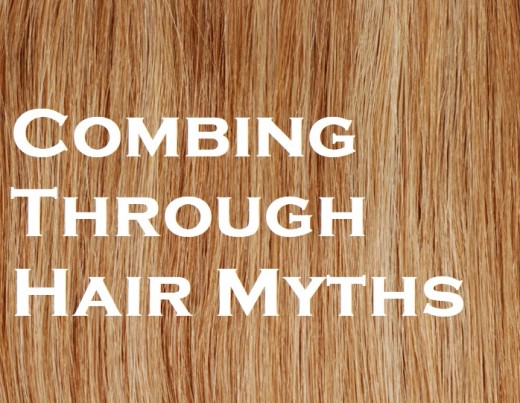All About Body Hair

Hairy Situations
Hair - It's the one part of our physical appearances most of us can alter to affect our outward appearance. We have it all over our body, some more than others. But, what makes it grow? Why and how does it grow? How come it is longer in some places? All of these questions and more will be answered shortly.
In the following segments, I will take you down a path of hair growth from head to toe. I'll bust a few myths about hair growth, as well as expose some truths that some of you may not know. The following information is based on scientific studies and research - no hair-brained ideas here.
Hairy Beginnings
As it is with any other subject, you need to know the origin of the subject at hand. How does hair grow in the first place? While I'll be using a few scientific words here-on, the process of hair growth is quite simple. There are 3 stages of hair growth cycle.
- Anagen - The first and last stage that your hair actually grows in length. During this stage, increased blood flow supplies oxygen to stem cells, which, in turn, begin dividing to create keratinocytes. These keratinocytes end up forming the root of the hair. As the keratinocytes are then pushed closer and closer to the surface of your skin, they eventually die and release a protein called keratin. Keratin is what holds a strand of hair together. Once the hair pops out of your skin, it is technically dead, which is why it doesn't hurt when you get your hair cut. Depending on the location, the anagen phase can last from 1 month to 7 years.
- Catagen - The second stage of the hair growth cycle lasts only a couple of weeks. In this stage, the production of keratinocytes is halted due to the blood supply being cut off from the hair follicle. While there is one more stage, this is essentially the "game over" stage for the life of a hair.
- Telogen - Also known as the resting stage, this is the stage that a hair just sits there. It's dead. It's just there. After 1-4 months the hair eventually falls out and the anagen phase starts all over again.
Why Does Hair Grow Longer in Some Places?
There are a couple simple answers to this question. First and foremost, hair growth is mainly affected by genetics. We all know a family that is famous for having thicker-than-normal hair. The second reason that hair grows longer in some areas than others, which is also affected by genetics, is because of the length of the anagen phases in those particular areas of the body. While the anagen stage on the scalp and facial regions normally range from 2-6 years, other areas of the body only have anagen stages of 30 to 45 days.
Beard and scalp hair can grow up to 1.25 centimeter per month, which is about 5 inches per year. Other hairs like eyebrows, eyelashes, arm, and leg hair only grow about 4-5 millimeters per month, which is why you don't have 4 inch long eyebrows. There is, however, no scientific explanation as it pertains to how your hairs know when to start and stop growing. The current school of thought is that stem cells create chemical signals that tell your hair when to grow and when to stop growing.
Pubic Domain
Why hair grows longer in some places usually leads into our next area of discussion - pubic hair. In girls, the growth of pubic hair starts between the ages of 8-14. Growth in boys starts a little later, between the ages of 10-15. The abridged version of why hair begins growing in your pubic region is because of hormonal changes your body undergoes. During puberty, your body begins to produce more sweat. One of the two sweat glands you have, the apocrine gland, starts producing more sweat during and after puberty. Since the apocrine glands are located only in your armpit and groin areas, scientists believe that these sweat glands stimulate the growth of pubic hairs.
Why are pubic hairs short and curly? This is due to the shape of the hair. Other hairs on your body are round in shape. Pubic hairs, however, are packed tightly which causes the follicles to produce an oval hair. This causes the hair to curl. The reason they are short basically goes back to the anagen stage we discussed earlier. They only grow for a short period of time.
What is the reason for having hair in those areas? While you'll probably hear about pubic hair being a cushion or some other term, the real reason for hair in our groin areas and armpit areas is mainly to help with friction. If you think about it, our groin and armpit area sustain the most friction on our body. We constantly move our arms or legs. This hair keeps us from rubbing ourselves raw in those areas. Other reasons for the location of these hairs is to protect the skin from bacteria, absorb sweat, prevent our lymph nodes from overheating, and to release pheromones.
To Shave or Not to Shave
Over the last few decades, shaving of pubic hair has become more common. But, what are the pros and cons of shaving the hair down there? Is it better to let it grow? This is a "you can't have your cake and eat it too" kind of question. Shaving the pubic area, as well as waxing or plucking the pubic area, can result in microscopic flesh wounds. We don't often think about this being a problem, but the exposure to our bloodstream from wounds allows bacteria or disease inside. Many cases of STDs are the result of a pre-existing flesh wound due to shaving or waxing. It doesn't help that people who aren't used to shaving this area typically itch more down there and end up scratching which can also result in open sores due to the breaking of the skin. On the other hand, studies have shown that the occurrence of pubic lice, aka crabs, have decreased drastically over the years because of the rising popularity of a clean-shaven pubic region. So, the choice is mainly up to you.
Does Shaving Make Hair Grow Thicker or Faster?
Since we are on the subject of shaving, I'd like to go ahead and debunk one of the most common myths of hair growth. Shaving does not, in any way, promote thicker or faster growing hair. As I stated before, once your hair penetrates the skin it is dead. Why would shaving it result in thicker or quicker growth? This misconception is probably due to the appearance of the root of your hair that is exposed after shaving. While the hair looks thicker after you shave, it is likely because it seems much darker against your skin, giving the impression that it is thicker. Thickness, however, stays the same. If you notice that your hair is growing back faster or thicker, it is most likely due to a change in diet or exercise regimen. Higher protein diets, as well as cardio exercise, have both been proven to stimulate thicker and quicker hair growth. While oils and shampoos can definitely help maintain your hair, they don't actually help it grow. It just stays a little longer and looks healthier. Biotin supplements have been proven to help hair growth, but mainly in people with biotin deficiencies.
The Lumberjack Beard
For those of you wondering how to get that trending, thick beard look, you may be out of luck. Now that we've debunked the myth that shaving promotes thicker, quicker hair growth, you may be wondering how does one get that luscious beard. Most people will tell you that it has to do with testosterone. While that is partially true, it isn't actually testosterone levels that affect hair growth. The chemical that affects hair growth is actually a more potent form of testosterone called DHT (dihydrotestosterone). DHT binds to androgen receptors, which means the more androgen receptors you have on your body the more hair you will have in those areas with the most receptors. Once again, genetics plays a vital part in the number of receptors you have on your body. While there are some products that have been proven to increase DHT levels, it is unlikely that you'll notice any drastic effects. In other words, if you are in your twenties and haven't been able to grow that thick, burly beard, you'll probably be struggling to grow one the rest of your life. On the bright side of things, higher DHT levels have been linked with male-pattern baldness. So, if you do have a scraggly beard, take some solace in knowing that you probably won't go bald anytime soon. For those of you who have high levels of DHT, don't worry, there are also medications that can help to lower your DHT levels and fight male-pattern baldness.
This concludes our journey into the world of hair. Sadly, there's not much you can do to stimulate hair growth, other than tweaking your diet and exercise routine. If you get plenty of exercise and take in lots of protein but still don't have the hair you want in certain areas, don't blame yourself. It's most likely your parent's fault. I'm sure they will provide empathy to your concerns if you confront them and probably welcome you for the gift of life they bestowed upon you. In conclusion, be happy with what you've got.
© 2018 Jesse James








